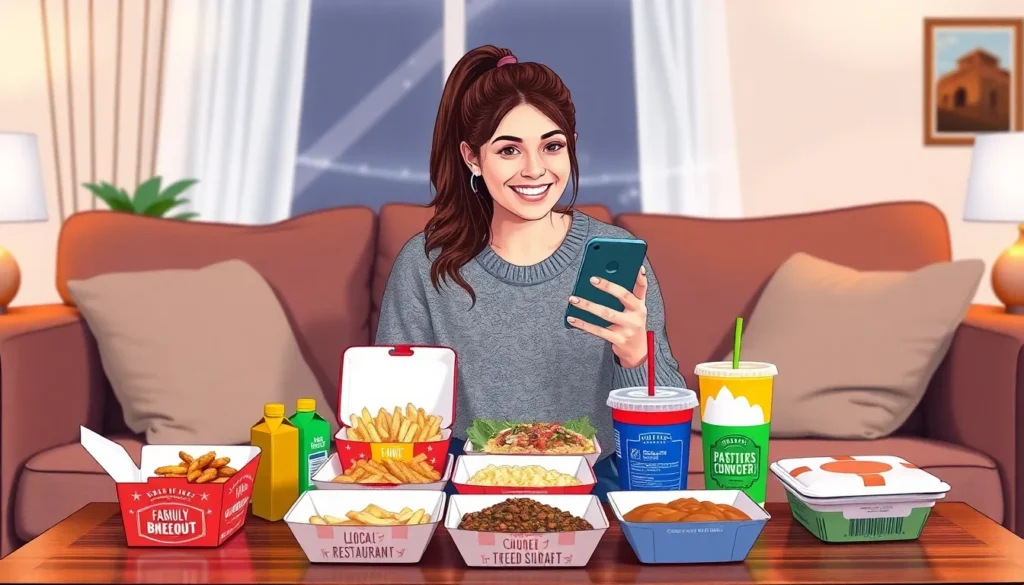In a world where sweatpants are the new business casual, food delivery has become the ultimate hero of modern dining. Gone are the days of waiting in long lines or wrestling with takeout menus. With just a few taps, a delicious feast can arrive at your doorstep faster than you can say “extra guac, please.”
Table of Contents
ToggleOverview of Food Delivery Trends
Food delivery services continue to evolve rapidly, reflecting changing consumer preferences and technological advancements. Increasingly, customers opt for delivery options that cater to their busy lifestyles. Mobile apps dominate the landscape, allowing users to browse menus, place orders, and track deliveries in real-time.
Sustainability remains a significant trend, with many services prioritizing eco-friendly packaging and delivering from local restaurants to minimize carbon footprints. According to a report from Statista, 43% of consumers in the United States prefer food delivery services that emphasize sustainable practices.
Dietary preferences shape the industry as well. Plant-based and organic options have gained traction, appealing to health-conscious consumers. Restaurants offer customizable meals, letting diners request specific ingredients to suit individual tastes.
Convenience drives the popularity of subscription models, which guarantee regular meal deliveries at reduced prices. These subscriptions cater to families and busy professionals seeking hassle-free dining solutions. A survey found that 30% of consumers are interested in meal kit deliveries due to the ease of preparation.
Speed remains paramount, with many services promising deliveries in less than 30 minutes. This focus on efficiency aligns with consumer expectations for immediate gratification. The integration of artificial intelligence enhances order accuracy and delivery efficiency, streamlining the entire process.
Ultimately, food delivery trends reflect a blend of convenience, sustainability, and customization. Evolving consumer demands shape these trends, showcasing a dynamic landscape that adapts to the preferences of modern diners.
Growth of Food Delivery Services

Food delivery services experienced significant growth, driven by a blend of technological advancements and shifting consumer habits.
Impact of Mobile Apps
Mobile apps transformed the food delivery landscape. Users now access a wide variety of menus at their fingertips, enabling swift ordering. Real-time tracking features enhance transparency, reassuring customers about delivery times. Services leverage user-friendly interfaces, streamlining the ordering process. Increased smartphone usage contributes to this trend, allowing more customers to explore dining options without delays.
Rise of Online Ordering
Online ordering continues to rise dramatically among consumers. Restaurants report increased sales due to streamlined processes and user engagement. Customer convenience stands out, as people prefer placing orders from home or workplaces. Targeted promotions through emails and apps attract more users, fostering brand loyalty. Data indicates that many consumers favor contactless options, reflecting changing preferences that emphasize safety and efficiency.
Changing Consumer Preferences
Food delivery trends significantly reflect shifts in what consumers seek from dining experiences. Growing health consciousness drives demand for healthier options, with more customers prioritizing nutritious meals. Some services now offer dishes that include organic ingredients, low-calorie options, and plant-based alternatives. Statistics show that 43% of consumers actively seek out healthier food choices when ordering online. Customers are increasingly inclined to select meals that align with personal wellness goals, pushing restaurants to adapt their menus.
Customization and personalization play vital roles in attracting modern diners. Many consumers value the ability to tailor their meals according to specific tastes and dietary restrictions. Some platforms allow users to modify ingredients or select portion sizes, enhancing satisfaction. Reports indicate that 60% of diners prefer customizable meal options over standard offerings. This flexibility fosters loyalty, as consumers enjoy curated experiences that cater to their individual preferences. The industry continues evolving, shaped by these imperatives for health and personalization.
Technology in Food Delivery
Technology drives innovation in the food delivery sector, enhancing user experience and operational efficiency.
Use of Artificial Intelligence
Artificial intelligence plays a pivotal role in streamlining food delivery services. It helps analyze customer preferences, ensuring tailored recommendations that align with individual tastes. Order accuracy improves as AI optimizes the preparation and delivery process. AI-driven algorithms handle demand forecasting, enabling restaurants to adjust inventory effectively. Efficiency has seen significant boosts, allowing numerous services to promise delivery times under 30 minutes. This technological integration supports restaurants by reducing food waste and enhancing customer satisfaction.
Contactless Delivery Solutions
Contactless delivery solutions have gained traction, reflecting heightened safety concerns among consumers. It offers peace of mind, allowing customers to receive orders without direct interactions. Many delivery apps now feature options for no-contact pickups or doorstep drop-offs. These advancements cater to changing preferences in hygiene and convenience. Increased utilization of contactless payment methods further supports this trend, encouraging swift transactions. Enhancements in tracking technology also empower customers to monitor their orders in real-time. Adapting to these preferences has become essential for services aiming to maintain customer loyalty and satisfaction.
Sustainability in Food Delivery
Sustainability significantly shapes the food delivery landscape. Many services now emphasize eco-friendly initiatives that lessen the environmental impact.
Eco-Friendly Packaging Initiatives
Packaging plays a crucial role in minimizing waste. Compostable containers, biodegradable materials, and sustainable packaging options increasingly appear in food delivery. Restaurants and businesses actively seek partnerships with suppliers who adhere to eco-friendly practices, ensuring alignment with consumer values. Statistics indicate that 75% of customers prefer brands that prioritize sustainable packaging solutions. Innovations in packaging now allow for reduced waste while preserving food quality. The push for sustainable alternatives reflects a collective effort toward a greener future.
Delivery Emissions and Solutions
Delivery emissions represent a growing concern in the industry. Many companies explore electric vehicles as an efficient solution to reduce carbon footprints. Utilizing bikes for short-distance deliveries also sees a rise; this method cuts emissions significantly. Implementing route optimization technology helps decrease unnecessary travel, enhancing efficiency. Research shows that routes optimized for time and distance can lower fuel consumption by up to 15%. As consumers become increasingly eco-conscious, services that prioritize emissions reduction strategies ensure long-term loyalty and market relevance.
Food delivery services are evolving rapidly to meet the demands of today’s consumers. With a focus on convenience sustainability and personalization these trends are reshaping dining experiences. As technology continues to advance the integration of mobile apps and AI enhances user interactions making ordering seamless and efficient.
Health-conscious choices and customizable meal options are becoming essential as diners seek nutritious and tailored experiences. The rise of contactless delivery methods reflects a commitment to safety while maintaining customer satisfaction.
As the food delivery landscape adapts to these shifting preferences it’s clear that the future of dining will be defined by innovation and a deeper understanding of consumer values.

